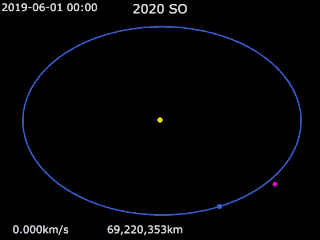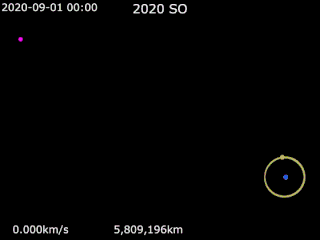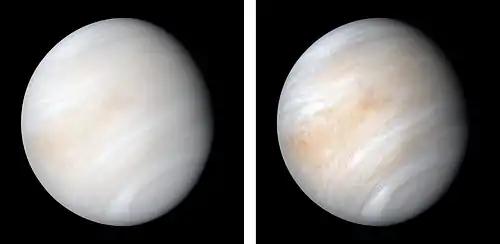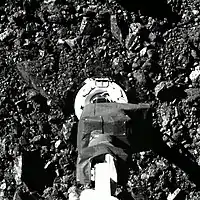2020 SO
2020 SO is a near-Earth object identified to be the Surveyor 2 Centaur rocket booster launched on 20 September 1966. The object was discovered by the Pan-STARRS1 survey at the Haleakala Observatory on 17 September 2020. The object was initially suspected to be an artificial object due to its low velocity relative to Earth and later on the noticeable effects of solar radiation pressure on its orbit. Spectroscopic observations by NASA's Infrared Telescope Facility in December 2020 found that the object's spectrum is similar to that of stainless steel, confirming the object's artificial nature.[9]
.gif) The orbit of 2020 SO around Earth and Sun from Nov. 2020 to Mar. 2021 | |
| Discovery [1][2] | |
|---|---|
| Discovered by | Pan-STARRS1 |
| Discovery site | Haleakalā Obs. |
| Discovery date | 17 September 2020 |
| Designations | |
| 2020 SO | |
| P116rK2 [3] | |
| NEO · Apollo (May 2020)[4] Atira (Dec 2020)[2] | |
| Orbital characteristics [4] | |
| Epoch 31 May 2020 (JD 2459000.5) | |
| Uncertainty parameter 3 | |
| Observation arc | 92 days |
| Earliest precovery date | 19 August 2020 |
| Aphelion | 1.072 AU |
| Perihelion | 1.002 AU |
| 1.037 AU | |
| Eccentricity | 0.03389 |
| 1.06 yr (385.77 d) | |
| 179.887° | |
| 0° 55m 59.495s / day | |
| Inclination | 0.1406° |
| 105.952° | |
| 331.313° | |
| Earth MOID | 0.01634 AU |
| Physical characteristics | |
Mean diameter | 6–12 m (assumed)[5] |
| 0.0026080±0.0000001 h[6] or 9.39 s | |
| 19.0 (current)[7] 22.4 (at discovery)[1] 14.1 (1 Dec 2020)[8] | |
| 28.81±0.60[4] 28.82[2] | |
Overview
As it approached Earth the trajectory indicated the geocentric orbital eccentricity was less than 1 by 15 October 2020,[10][lower-alpha 1] and the object became temporarily captured on 8 November when it entered Earth's Hill sphere.[11] It entered via the outer Lagrange point L2 and will exit via Lagrange point L1. During its geocentric orbit around Earth, 2020 SO made a close approach to Earth on 1 December 2020 at a perigee distance of approximately 0.13 lunar distances (50,000 km; 31,000 mi).[4] It will also make another close approach on 2 February 2021, at a perigee distance of approximately 0.58 LD (220,000 km; 140,000 mi).[4] Since discovery the time of uncertainty for the February 2021 closest approach to Earth has been reduced from ±3 days to less than 1 minute.[4] It will leave Earth's Hill sphere around 8 March 2021.[12][lower-alpha 1]

Paul Chodas of the Jet Propulsion Laboratory suspects 2020 SO of being the Surveyor 2 Centaur rocket booster, launched on 20 September 1966.[11][12][13] The Earth-like orbit and low relative velocity suggest a possible artificial object. Spectroscopy may help determine if it is covered in white titanium dioxide paint.[14] Goldstone radar will make bistatic observations transmitting from the 70-meter DSS-14 and receiving at the 34-meter DSS-13.[15] As a result of the bistatic DSS-14/RT-32 radar observations, a rotation period of about 9.5 seconds was obtained,[16] which corresponds to the photometric observations.[6] Obtained range-Doppler radar images[16] confirm that the object has an elongated shape with a length of about 10 meters and a width of about 3 meters.
Around the time of closest approach on 1 December 2020, the object was only brighten to about apparent magnitude 14.1,[8] and required a telescope with roughly a 150mm (6") objective lens to be seen visually.[17] It displays a large light curve amplitude of 2.5 magnitudes, signifying a highly elongated shape or albedo variations on its surface. It has a rotation period of approximately 9 seconds.[18]
At the time of its discovery, 2020 SO had unremarkable motion typical of a main-belt asteroid. However, the four observations that Pan-STARRS obtained over the course of 1.4 hours showed non-linear motion due to the rotation of the observer around Earth's axis, which is a signature of a nearby object.[1][10]
| Parameter | Epoch | Orbit type |
Period (p) |
aphelion (Q) |
perihelion (q) |
Semi-major axis (a) |
inclination (i) |
Heliocentric eccentricity (e) |
Geocentric eccentricity (e)[10][lower-alpha 2] |
|---|---|---|---|---|---|---|---|---|---|
| Units | (years) | AU | (°) | ||||||
| 2020-May-31[4] | Apollo | 1.056 | 1.0722 | 1.0020 | 1.0371 | 0.14061° | 0.03389 | 737 | |
| 2020-Dec-17[2] | Atira | 0.980 | 0.9882 | 0.9847 | 0.9865 | 0.13842° | 0.00180 | 0.89934 | |


In January and February of 2036, it will again approach Earth with a geocentric eccentricity less than 1 since the relative velocities will be small,[10] but will not be within Earth's Hill sphere of 0.01 AU (1.5 million km).[4][lower-alpha 3]
See also
- J002E3
- 2018 AV2, a similar "asteroid" discovered in 2018 in a temporary orbit around Earth, now no longer considered to be an asteroid, but suspected to be the Snoopy module from Apollo 10
- Temporary satellite
Notes
- The JPL Horizons On-Line Ephemeris System shows the geocentric orbital eccentricity dropping below 1 by 15 October 2020. But a second condition for capture is that the object is within Earth's Hill sphere which has a radius of roughly 0.01 AU (1.5 million km). Meeting both conditions is when the object is in a temporary satellite capture around Earth.
- Orbital eccentricity must be below 1 to be orbiting the central body.
- An object needs to be within Earth's Hill sphere to truly be in orbit. An object 1AU from Earth could have a geocentric e<1 if the relative velocities are small, but we would not say it is orbiting Earth.
References
- "MPEC 2020-S78 : 2020 SO". Minor Planet Electronic Circular. Minor Planet Center. 19 September 2020. Retrieved 20 September 2020.
- "2020 SO". Minor Planet Center. International Astronomical Union. Retrieved 20 September 2020.
- "2020 SO". NEO Exchange. Las Cumbres Observatory. 18 September 2020. Retrieved 20 September 2020.
- "JPL Small-Body Database Browser: 2020 SO" (2020-12-01 last obs.). Jet Propulsion Laboratory. Archived from the original on 21 September 2020. Retrieved 20 September 2020.
- "NEO Earth Close Approaches". Center for Near Earth Object Studies. Jet Propulsion Laboratory. Retrieved 10 October 2020.
- Peter Birtwhistle (Great Shefford Observatory). "Light curve".
- "2020SO". Near Earth Objects – Dynamic Site. Department of Mathematics, University of Pisa, Italy. Retrieved 20 September 2020.
- "2020SO Ephemerides for 1 December 2020". NEODyS (Near Earth Objects – Dynamic Site). Archived from the original on 26 September 2020. Retrieved 26 September 2020.
- "New Data Confirm 2020 SO to be the Upper Centaur Rocket Booster from the 1960's". NASA. 2 December 2020. Retrieved 2 December 2020.
- Horizons output. "Geocentric Orbital Elements for Asteroid (2020 SO)". Retrieved 27 September 2020. ("Ephemeris Type" select "Orbital Elements" · "Center" select 500 for Geocentric. Output lists Eccentricity as "EC".)
- "Earth May Have Recaptured a 1960s-Era Rocket Booster". NASA. 12 November 2020. Retrieved 12 November 2020.
- Dunn, Marcia (11 October 2020). "Fake asteroid? NASA expert IDs mystery object as old rocket". phys.org. Retrieved 12 October 2020.
- Alan Harris (20 September 2020). "Re: another natural satellite of Earth... again". Retrieved 20 September 2020.
- B., Mark (12 October 2020). "NASA Expert Believes New "Asteroid" is a Discarded Rocket Part". The Science Times. Retrieved 3 November 2020.
Spectroscopy on the surface of 2020 SO can also determine whether it has titanium dioxide - the paint material used on space rockets.
- "Goldstone Radar Observations Planning: 2020 SO". Asteroid Radar Research. Retrieved 30 November 2020.
- "2020 SO · IAA RAS". iaaras.ru. Retrieved 10 December 2020.
- "Limiting Magnitude". The Wilderness Center Astronomy Club. Retrieved 26 September 2020.
- Masi, Gianluca (2 December 2020). "Near-Earth object 2020 SO: rotation and time-lapse – 01 Dec. 2020". Virtual Telescope Project. Retrieved 2 December 2020.
External links
- Earth May Have Recaptured a 1960s-Era Rocket Booster, Tony Greicius, NASA, 12 November 2020
- Animation of the Line of Variation (via clone orbits) stretching out from December 2020 to May 2021
- "Pseudo-MPEC" for P116rK2, Project Pluto, 19 September 2020
- 21 Nov 2020 image – Osservatorio Sormano / E. Colzani
- 01 Dec 2020 image and rotation – Virtual Telescope Project / G. Masi
- 01 Dec 2020 time-lapse and photometry – Virtual Telescope Project / G. Masi
- 2020 SO at NeoDyS-2, Near Earth Objects—Dynamic Site
- Ephemeris · Obs prediction · Orbital info · MOID · Proper elements · Obs info · Close · Physical info · NEOCC
- 2020 SO at ESA–space situational awareness
- 2020 SO at the JPL Small-Body Database


_on_Jul_14_2020_aligned_to_stars.jpg.webp)